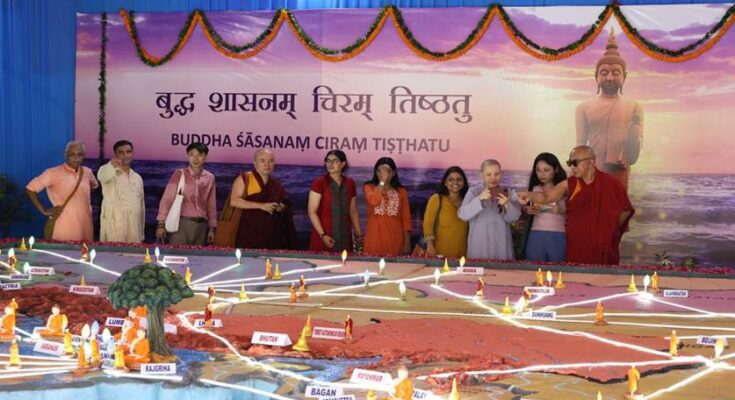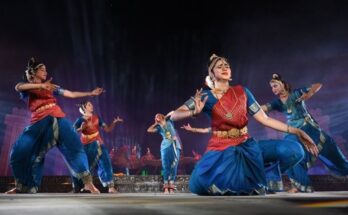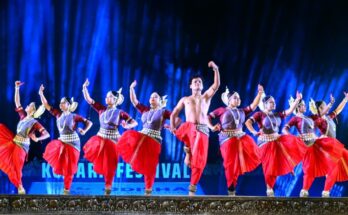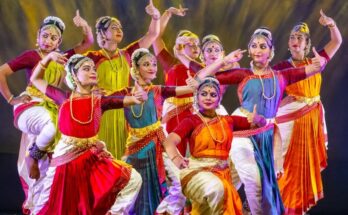Footsteps of the Buddha : Indira Gandhi National Centre for the Arts (IGNCA), through its Brihattar Bharat and Area Studies , held an exhibition ‘Footsteps of the Buddha: A Sacred Map- an exhibition that offers a contemplative journey into the life of the Buddha and the far-reaching influence of his teachings across Asia. Rooted in the timeless aspiration ‘‘Buddhasasanam Chiram Tisthatu” (“May the Buddha’s Teachings Endure Forever”), the exhibition showcases a meticulously hand-crafted fibre map, the result of year-long research and artistic engagement.
The map brings into focus the four sacred sites- Lumbini, Bodhgaya, Sarnath, and Kusinagara-not merely as geographical points but as living spaces of awakening, spiritual transmission, and memory. It further traces the journey of the Dharma through the landscapes of Mathura, Gandhara, Khotan, Luoyang, Dunhuang, Yangon, Angkor Wat, Borobudur, and beyond-highlighting how the Buddha’s message travelled through deserts, seas, and civilisations, carried by monks, pilgrims, scholars, and emissaries whose efforts shaped the cultural and spiritual fabric of Asia. The exhibition will remain open to the public until the 15th of August.
Present on the occasion was Venerable Geshe Dorji Damdul, who graced the event as Chief Guest. The other distinguished guests were in attendance including Smt. Lily Pandeya, Joint Secretary, Ministry of Culture; Dr. Sachchidanand Joshi, Member Secretary, IGNCA; Shri Ravindra Pant; Director, Academics IBC, Shri Shyam Parande, International Coordinator, Sewa International and Secretary General, Antarrashtriya Sahyog Parishad; Shri Bal Mukund Pandey from Akhil Bhartiya Itihas Sankalan Yojana; Dr. Priyanka Mishra, Director, IGNCA; and Prof. Dharma Chand Choubey, Head, Brihattar Bharat and South-East Asian Studies Unit of IGNCA. Venerable monks and nuns from Mongolia and Vietnam were also present on the occasion.
Venerable Geshe Dorji Damdul, speaking on the occasion, stated that it is not enough to speak of taking the Buddha’s message to the world; we must first embody it within ourselves. Before spreading compassion outward, he reflected, one must ask-am I happy, is my family happy? If there is no compassion within the home, no outward effort can carry the true essence of the Dharma. Just as one cannot export gold without first possessing it, he observed, we cannot share the Buddha’s wisdom unless we live it. Marking the 90th birth anniversary of His Holiness the Dalai Lama and observing this year as the Year of Compassion, he urged all to begin by cultivating compassion in their own hearts and homes. Only then, he added, can India truly offer this message of healing and harmony to the world.
Smt. Lily Pandeya, Joint Secretary, Ministry of Culture, remarked that this is a deeply significant and proud moment for India. She highlighted that in a remarkable turn of events, sacred relics of the Buddha-traced to an upcoming international auction- have been respectfully repatriated to India, in alignment with the Hon’ble Prime Minister’s vision for the return of cultural artefacts.
She reiterated that with the support of the Godrej Industries Group and through a public-private partnership model, the Ministry of Culture facilitated their safe return. The relics arrived in Delhi on 30th July and are now in the care of the National Museum. “We are working towards a major exhibition that will bring together these sacred relics with the IGNCA’s map model that traces the global spread of Buddhism,” she stated. The initiative, she affirmed, reflects India’s enduring commitment to peace, compassion, and dialogue—the eternal message of the Buddha.
Dr. Sachchidanand Joshi said on the occasion that the return of the sacred relics of Bhagwan Buddha and the inauguration of the exhibition came together as a moment of profound joy—truly a cherry on the cake. He noted that the exhibition was envisioned especially for the younger generation and urged institutions, schools, and colleges to visit and engage with how the message of Bhagwan Buddha—of peace, happiness, and compassion—once spread across civilisations and why it remains deeply relevant in the present day. Reflecting on the insights shared by the venerable monks, he emphasised that the deeper one engages with the life and teachings of the Buddha, the more one turns inward. It offers an opportunity for self-introspection and ultimately, self-actualisation, which he felt is the need of the hour.
In his opening remarks on the exhibition, Prof. Dharam Chand Choubey said that it presents a compelling visual narrative of Prince Siddhartha’s transformation into the Buddha and the far-reaching spread of his teachings. The map traces how the Dharma journeyed beyond India through the devotion of monks and scholars who crossed mountains and oceans—often at great personal cost. He noted that it is not merely a cartographic representation, but a tribute to those who carried the Buddha’s message across Asia-alongside India’s civilisational wealth in ethics, science, art, and knowledge systems; that helped shape a culturally Indianised Asia.
On this occasion the other guests also expressed their views on the occasion. In the end a vote of thanks was extended by Dr. Ajay Mishra. More than a visual display, the map honours the human stories behind this expansive movement-of courage, loss, resilience, and profound dedication. It reflects the Buddha’s teachings not only as religious philosophy but as a civilisational force that fostered dialogue, artistic exchange, and shared values across nations. Through this exhibition, IGNCA once again affirms India’s role as Vishwamitra-a friend of the world—offering the enduring wisdom of the Buddha as a guide for reflection, unity, and global harmony in our times




